Abstract | PDF | UnDisciplined (Feb 2020) | Request Permissions
Undoing as Activism
Jill Price
Biography | Notes
Keywords: Undoing, Activism, Sustainability, Materialism, Textiles
To undo, unfeel, unlearn, unthink, unmake, unteach, unstitch, unweave, untangle, untie, unfasten, unwrap, unknot, unravel, unwind, unsettle… It would seem Un as a prefix signals us to undo the outdated tapestry of colonial, capitalist and patriarchal systems and thought upon which an abundance of human and non-human material is visibly and invisibly sacrificed in the name of economic growth. As UN naturally suggests that something could be undone, I find myself asking, what does it mean to undo?
Currently engaged in Cultural Studies PhD at Queen’s University, my research-creation thesis, Unmaking One’s Way Out of the Anthropocene, explores undoing and unmaking as creative acts. Specifically working from my position as a creative producer within the visual arts, I am investigating how undoing might be arrived at through the physical unmaking or taking apart of existing material and immaterial things to arrive at something different or new.
This question stems from a new level of awareness of the ecological and social trauma woven into the global systems of trade and economies of waste. Although not specifically named within Karl Marx’s writing on “modern capitalism”[1] and “commodity fetishism”[2], like the desire for things, globalism further “alienates”[3] us from the endless assemblages of unjust and toxic materials attached to or left behind by any one given object.
No longer able to deny the physical and psychological by-products of transcontinental production and exchange, I have become hyper-sensitive to the realities of my Canadian settler history, present and future amidst a culture that remains complicit in the erasure of arable land both abroad and at home. This sensitivity has led me to see globally manufactured, transported, consumed and discarded goods as physical and “lively”[4] extensions of neo-colonialism, where objects now have agency above, below and across our shared landscapes. This concept becomes clear in Jane Bennet’s book Vibrant Matter when she writes “trash is not “away” in landfills but generating lively streams of chemicals and volatile winds of methane.”[5] From this one sentence Bennet helps us to understand how chemically treated and transformed materials inevitably return to a variety of human and non-human geographies, ultimately effecting the existence or non-existence of its inhabitants.
From the dense entanglements of these highly interconnected assemblages of matter, in Louis Althusser’s words, I have been “hailed.”[6] But rather than being hailed by a capitalist regime, I have been hailed by the earth to resist moments when I feel the urge to put more stuff into the world or take up time-lapse technologies that document creative production at record speeds. By taking up the “hail” to undo or unmake that which has already been made, I would like to think that I am exerting a form of resistance to all those other materialisms that demand our participation and contribution towards the accelerated and never-ending production and consumption of goods. Through these gestures I hope to somewhat undo or distance myself from the ideological beliefs and cultural behaviours that contribute to global systems of ecological devastation and human degradation. So what does it mean to truly undo the capitalist apparatuses that continue to contribute to trauma today and repeat the violence of our entwined histories?
Going to its etymology, undo is a verb that undoes itself at its very inception as it implies that we might be able to “cancel or reverse the effects or results of a previous action.”[7] Somewhat synonomous with the word deconstruct, undo similarily demonstrates the complexity of language pointed by Jacques Derrida in his essay Différance.[8] Unlike the word deconstruction, undo does not imply that things need to be reconstructed, but rather proposes something be returned to an earlier state. This failure of undoing as a concept becomes crystal clear when we consider the reality of decolonization as the return of land back to Indigenous peoples, a position powerfully clarified by scholars Eve Tuck and Wayne Yang in their essay “Decolonization is not a Metaphor.”[9] While giving back land to First Nation, Metis and Inuit communities of North America is the right thing to do, this in no way would erase or undo the decades of cultural genocide experienced by multiple generations.
More negatively, one might say that to undo something is to “cause the downfall or ruin” of something,[10] a definition that then becomes positive when brought into the realm of philosophy or the world of theory. In these contexts, to undo might suggest one attempts to demonstrate a critical practice of thinking, reading, teaching and observing where one is constantly unmaking how they perceive or present the world.
When expanded into undoing, undo can also become a noun where it is an “act to undo a previous unacceptable act or thought. […] Often in the form of an apology, […] or a confession.”[11] Undoings also refers to gestures or small gifts that attempt to stand in place of a verbal apology or taking accountability for one’s actions.
If we look at the field of psychology, undoing is referred to as a defence mechanism in which a person tries to cancel out or remove an unhealthy, destructive or otherwise threatening thought or action by performing or speaking in a way that contradicts an earlier mishap.[12] Addressed by Sigmund Freud and furthered by his daughter Anne Freud, the German term “Ungeschehenmachen”[13] literally means “making un-happen”[14] when translated. This is essentially the core of undoing with undoing referring to the phenomenon whereby a person tries to alter the past in some way to avoid adversity, conflict or mishap. On the flip side of the same coin, if we don’t undo, remove or cancel out unhealthy relationships, threats, ideas or behaviour, can lead to our own undoing.
Materially, Undoings and unmaking have been progressive and ecological methods since the beginning of time, with different peoples having to produce, repair and transport tools for their own use. Migratory populations particularly understand the benefits of something that is able to come apart. Out of necessity, some nomadic Indigenous people such as the Cree and Chipewyan arrived at larger sheets of textiles by piecing together hides. The stitching together of furs and skins enabled the creation of tipis, rugs, blankets and clothing. Yurts first constructed by Mongolian hunters and herders, also provide us another example of early innovative structures strategically engineered for rapid dismantling, speedy reconstruction and efficient repair.[15] By simply looking at these few examples, there is no denying how Indigenous design and ways of knowing could help us undo the ecological mess we are in.
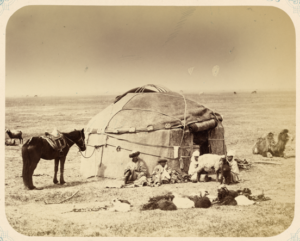
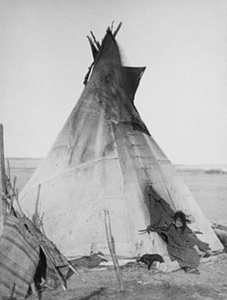
In a special issue of Ecology and Society, an article entitled “Reconnecting Art and Science for Sustainability” outlined how during a long-term action-research project among three Kawaiwete indigenous groups in the Brazilian Amazon, Janet Chernela discovered how undoing assisted in the revitalization of artistic knowledge of basketry and textiles among men and women. Understanding that “material cultural objects are signifiers of history and can be agents in the construction of history, having consequences in the social and political life of indigenous peoples,”[16] Chernela worked with local indigenous organizations and NGOs in Brazil to acquire baskets and weavings once held only in the country’s museums. The researcher’s goal was to to reconnect community members with objects that held ancient knowledge, which if reacquired, might offer skills that could lead to self-sustenance and sovereignty from the forestry, development and tourism that continues to threaten their communities. Beyond the unmaking of objects, lost knowledge and economic disparity, this example also served to illustrate how collaborative and participatory approaches to knowledge acquisition can undo Western approaches to knowledge retrieval and construction so as to make room for “other forms of knowing and diverse ontological worldviews.”[17]
Similar projects in Guatemala under the facilitation of the organization Horizon and Women’s Association for the Development of Sacatepéquez (AFEDES), temporarily helped to undo “social and political marginalization” of women. With over 75% of Indigenous Kaqchikel women dependant on their spouses’ income, they returned to weaving as a way to soften the effects of poverty and malnutrition suffered by themselves and their families. In response to the project, Guatemalan weaver Brenda Marison Bucú Puac was quoted as saying,
Weaving is a work of art that represents the essence of Indigenous peoples. Each time we undo a thread, we do so with love because this is a way for us to ‘undo’ our sadness, our anxiety and our fear – and every time we weave the thread back, we are weaving our ideas, our thoughts and our dreams.[18]
Unfortunately, as reported by the AFEDES, the effects of centuries of discrimination, violence, and racism led to a decline in the production and social acceptance of the textiles. Another cultural blow occurred when industrial, large-scale companies exploited the situation by appropriating Mayan designs and patterns for commercial gain without respect or remuneration for Indigenous communities.[19]
Beyond signaling to how much we still need to undo, including the appropriation of Indigenous knowledge for the production and capitalization of academic research,[20] some Indigenous ways of being with objects makes me try to understand my own relationship with things. Why do I have so little connection with things that surround me? How do I not know who made my clothes or where they truly came from? How do I begin to undo all that distance between myself and the network of human and non-human materials?
To undo this distance perhaps one needs to investigate a time where material excess may have got its legs. On her blog The Regency Redingote, Kathryn Kane whimsically and yet seriously addresses a time beginning in the late medieval period and continuing into the years of European colonial expansion, when “aristocratic ladies” engaged in the practice of parfilage. Also known as drizzling, parfilage was the act of removing precious metal threads from embroidered textiles. At times done for pleasure or as a way to organize large social gathering, women considered parfilage as an opportunity to “show off” their “graceful hands in motion,”[21] Parfilage also became a source of much-needed funds when the French Revolution began to take its toll on the aristocrats of France.
As frivolous and tedious as this sounds, Talia Schaffer’s book, Victorian Domestic Handicraft and Nineteenth Century Fiction, suggests that these acts of undoing, as revealed through the writing of the time, were quite sincere in engaging with issues of recycling, sentiment, economic alterity. These forms of unmaking also offered a means of self-expression, social participation, and cultural definition for women who were perhaps resisting or acting out against over-determined gender roles and their required performance during these times.[22] An example of early feminism could be extracted from the collected stories that record women carrying out deviant acts during parties and other social gatherings in which they would cut away parts of gentlemen’s jackets and adornments from military uniforms so they could brag about their rapidness and bravery once safely back together in the salon and able to return to the act of drizzling.[23] Schaffer also suggests that these public “undoings” reflected France and Britain’s “post–French Revolution preference for simplicity and rejection of ornate and courtly aesthetics” and served as a physical gesture by two colonial nations that could offer a “visible and tactical critique of the ancient regime.”[24]
Those incarcerated or in need during Victorian times put to work “junk picking,” provides an example of how productive and resourceful acts of undoing can be unjust the the health or well-being of labourers isn’t taken into account. Junk, once meaning old ship rope and wire, would be cut and untwisted so as to arrive at individual fibres that could then be mixed with tar to create oakum, which served as an excellent medium to fill holes and spaces between a ship’s floor and wall boards to make it water tight. Although seemingly a wonderful example of institutional environmentalism, this practice of “junk picking” was extremely difficult on the hands, often leading to sores and infection from the grime. Overseers also argued that the work was too easy, sedentary and provided workers too much opportunity to correspond and organize with one another. To deny prisoners the benefits of socialization and conversation steps were taken to separate them,[25] a systematic form of division and isolation still found in many work environments today.
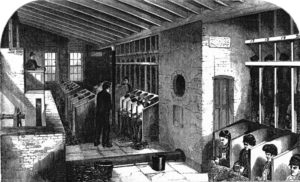
In national and global times of hardship during World War I and World War II, unmaking was required to supplement materials much in demand. Wool, the only fibre able to keep troops both warm and dry, was so sought after that households rich or poor would undo existing clothing so as to do remain in good standing as patriots at home. As many of the war time knitters began as amateurs, completed garments often required undoing to ensure that no irregularities would cause unnecessary sores or discomfort while in the trenches. During this time, knitting helped to temporarily undo or unmake the delineation between the roles of the sexes, since men of all statures were expected to knit both at home and in public. For a time, this nation-wide movement also helped to dismantle the idea that the machine was better. It was often expressed by both the soldiers and the knitters that in receiving or giving something handmade, you are also receiving or giving of one’s love, time and support. Further, knitting was used by injured soldiers as therapeutic practice to help undo or unmake the stress, boredom and sense of uselessness that came with being temporarily out of commission.[26]
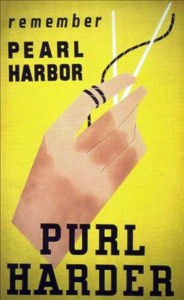
Looking at contemporary art practices that involve unmaking or undoing in order for art to intersect with activism, there is a long line of artists who have worked to unravel flags over the years. Artist Sonya Clark began unthreading the Confederate Flag at the Mixed Greens Gallery in New York on April 9, 2015 as a way to point to how “slow and toilsome”[27] the task is of dismantling the ideals of the Confederacy and the notion of racism in the United States. This was a symbolic and weighted gesture, occurring amidst many Black Lives Matter responses to tragedies in Ferguson, Baltimore and Cleveland as well as taking place on the 150th anniversary of when Robert E. Lee surrendered the last major Confederate army, Clark shared,
The performance of it is almost a meditative kind of, “what does it mean to undo the symbol?” … What does it mean to then use the raw elements that came together to make this symbol? To take them apart and potentially make something new again out of that?[28]
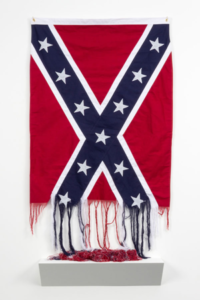
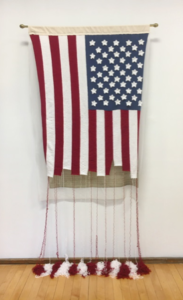
Not too long after, on January 21, 2017, an artist from Lexington Massachusetts named Adrienne Sloane opened a very timely installation at the Fuller Craft Museum entitled “The Unravelling.” Coinciding with the inauguration of President Trump, the artist positioned a hand-knit American flag atop the US Constitution and began to unravel the flag stating that until the current Trump government is brought to accountability or unseated from its power, she would gradually undo the flag to remind the American people of what the constitution is meant to do.[29]
Moving onto the unmaking of garments, Amsterdam design collective Lernert & Sander produced a video entitled Last Season. This video documented the collaborative creatives unmaking sweaters by Prada, Jill Sander, Celine and Chloe; garments normally priced between 1,000 and 1,500 Euros. Commissioned by Holland’s only Prada stockist and boutique owner Kiki Niesten, the well-known designers, marketers and artists were invited to create a window display that would tie into or draw attention to Niesten’s storefront during Maastricht’s famous art fair Tefaf. The artists explained, “the process of taking apart the expensive duds was soothing and satisfying, a literal rebellion against the idea of a $1,300 sweater.” Although gently critiquing the textile industry and capitalist greed, the artists still managed to sell video stills of the performance for 750 Euros a piece in addition to monetizing the balls of yarn for undisclosed amounts; actions that clearly demonstrate how difficult it is to undo oneself from the exploitive and inequitable realities of corporate capitalism.[30]
Looking to unmake industrially machined garments from a different perspective is Kingston University graduate Imogen Hedges. Inspired by all of the old sweaters her grandmother had knit her over the years and discovering that charity shops sometimes spend hours unraveling sweaters as they get more money from the wool than the sweaters, Hedges designed an unknitting machine built around an old bicycle frame. The “un-knitter”, who sits on a chair at one end, pedals to unravel the garment. The yarn then passes through the steam of an electric kettle to remove its kinks. The undone yarn then it finds its way to a hand-cranked spindle where it is rewound into a ball for re-knitting.[31]
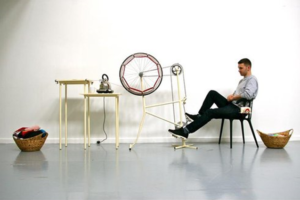
From an industry point of view, Prato’s textile district, known for being at the forefront of ecological and sustainable practices, has been creating regenerated textiles since 1840. Continuing to use methods of collection and sorting to undo production stages of dying, a highly toxic process, their factory ensures that at least sixty-five percent of all fibres being used in the creation of new fabrics have come from past textiles. Sorted by hand for colour and texture, the company reintroduces human labour and care into their chain of production, systematically undoing the environmental devastation and slave labour often associated with the production of textiles. Now serving as a model for over 100 enterprises in the Italian Textile and Recycling Association, Prato’s textile manufacturing strategies offers us a prototype of how we might ensure we are producing and consuming “happy objects,”[32] which Sara Ahmed defines as those goods or services that bring people back into closer proximity with materials, other people, their own bodies and in turn with the products of their labour.
Turning our view to Canada, even cities like Toronto are beginning to vigorously take up recycling and repurposing as a way to slow, diminish or undo the astronomical rate at which we send fast fashion to landfills at home and abroad. Claudia Marsales, a senior waste manager for the city of Markham is so committed to recycling she has been dubbed “the Queen of the Heap.”[33] Starting up pilot projects and communication strategies with the goal of increasing clothing recycling from 15% recycled today to 100% in the near future, this level of undoing would serve as an exemplary model for how other North American cities could address their waste.[34]
Personally, it wasn’t unitl the fall of 2018 that I began to physically explore undoing by unmaking an acrylic wool blend, machine knitted poncho I had acquired in Portugal that had become stained and shrunken over time. During this durational performance entitled Undoing #1, I sat in solitude for over three hours calmly and not so calmly struggling to unravel the tightly knit garment. Serendipitously, the repetitive act of untangling drew attention to labour and how materials have memory, history and value outside of their manufactured form. Once screened, the video recording of this gesture produced, by chance, sound that was identified as offering Autonomous Sensory Meridian Response (ASMR) to certain listeners who experience “low grade euphoria.”[35] For some this euphoria is characterized by “a combination of positive feelings and a distinct static-like tingling sensation on the skin.”[36] I was pleasantly surprised to discover that by recording the act of unravelling, undoing proved to be generative, producing other sensory materials through chance.
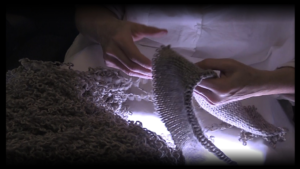
This exploration continued by engaging in a variety of undoings from unravelling clothes to undoing my perceptions on work, art, activism, and resistance with the aim to draw attention to the vibrancy and relationality of all living and non-living matter, once again touched on by Jane Bennett’s text, Vibrant Matter: A Political Ecology of Things.[37] Pulling from her lecture Powers of the Hoard: Artistry and Agency in a World of Vibrant Matter, Bennett suggests “hoarders may have an exceptional awareness of the extent to which all bodies can intertwine, infuse, ally, undermine, or compete with those in its vicinity.”[38] Currently spotting, documenting, collecting and caring for lost and discarded textiles in a series I call Groundlings, I feel as though these actions have led me to have more empathy for things and the other material beings to which they are attached.
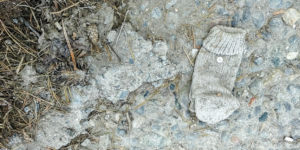
Highly aware of the risk of flattening non-human and human material through this titling, I feel I am experiencing first hand what Bennet means when she states, “to begin to experience the relationship between persons and other materialities more horizontally is to take a step toward a more ecological consciousness.”[39] Initially only sought after for narratives about global, ecological entanglements between human, animal, machine and plant, the meaning of this finding, gathering and repairing has expanded so as to acknowledge local ecologies of homelessness and bodies often deemed as excess by the neo-liberal capitalist powers that be. By picking up lost and discarded textiles, I also now recognize how much other material remains on the ground and how each one of those objects embodies another tightly woven tapestry of physical, social, political, economic and psychological material.
Further along in my understanding of what it would mean for me to truly undo how I produce, move, transmit and consume in the world today, I am looking to move beyond small gestures that merely recognize trash as an extension of colonization and ask what else needs to be undone or unmade? Who needs to come together to assist in the unmaking of these other immaterial things? Does everything need undoing or do we need to realize that nothing can be undone? And, if we can’t undo what has been done, how do we recraft that which we know today, but want to experience in the future? Perhaps, a couple of verses from Margaret Atwood’s poem, The Animals Reject their Names and Things Return to Their Origins can provide some clues.[40]
I. It was the bear who began it. Said,
I’m getting out from under.
I am not Bear, l’Ours, Ursus, Bär
or any other syllables
you’ve pinned on me.
Forget the chateau tapestries
in which I’m led in embroidered chains.
and the scarlet glories of the hunt
that was only glorious for you,
you with your clubs and bludgeons.II. At this the dictionaries began to untwist,
and time stalled and reversed;
the sweaters wound back into their balls of wool,
which rolled bleating out into the meadows;
the perfumes returned to France
and old men there fell sweetly dead
from a surfeit of aroma.
Priests gave their dresses up again
to the women, and the women ditched their alligator shoes in a hurry
before their former owners turned up to claim them.